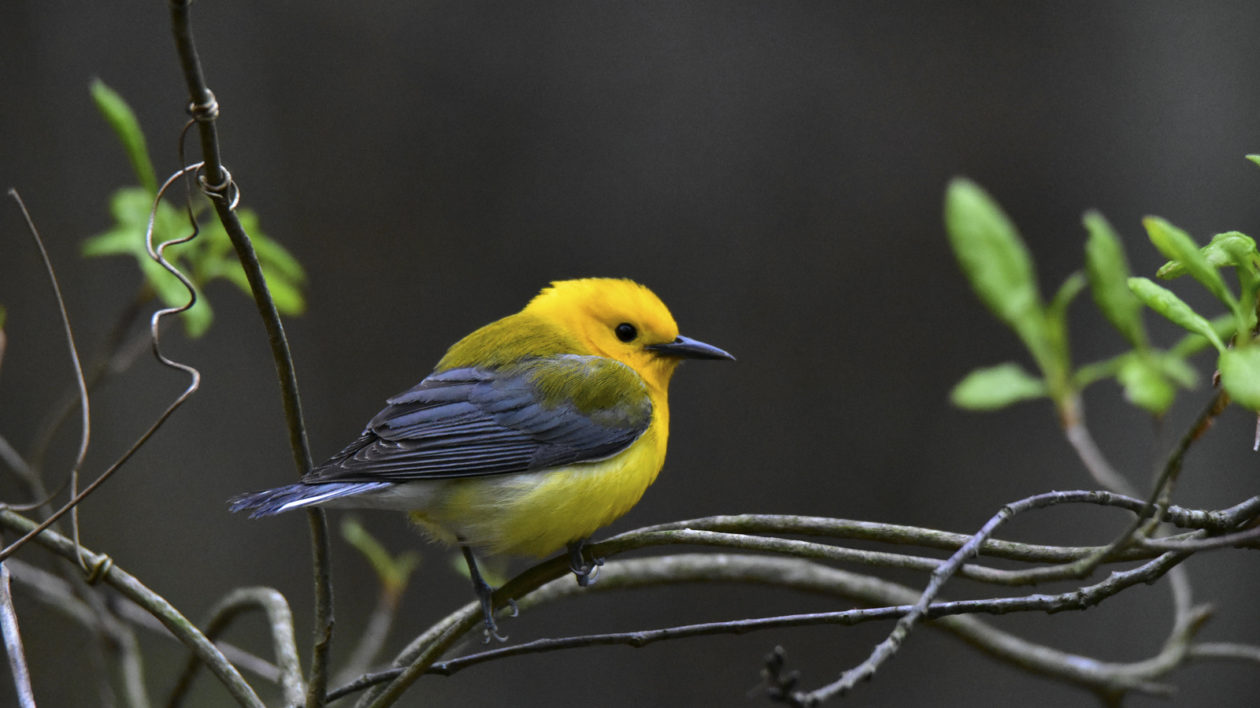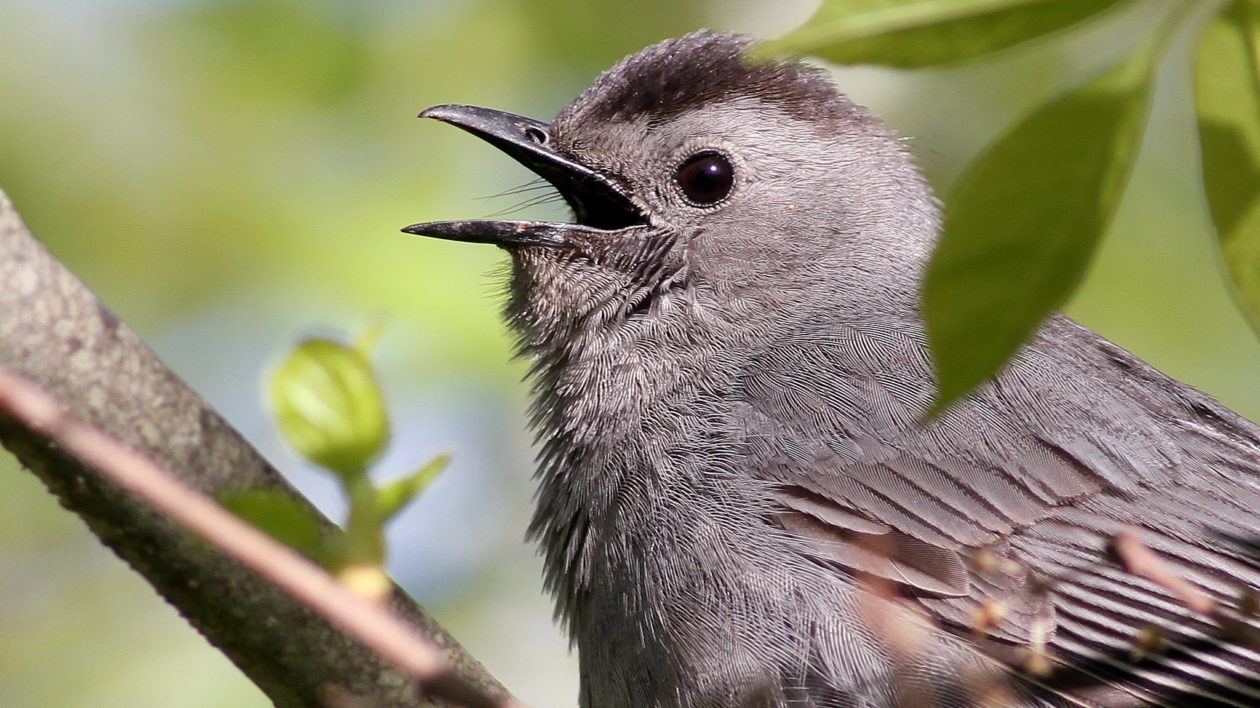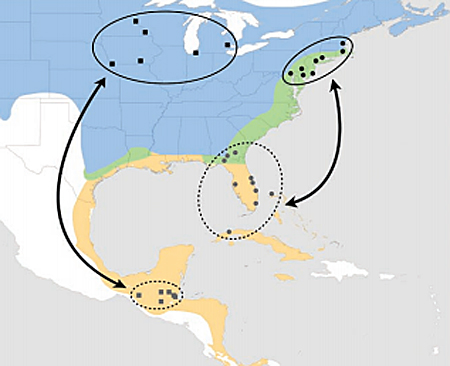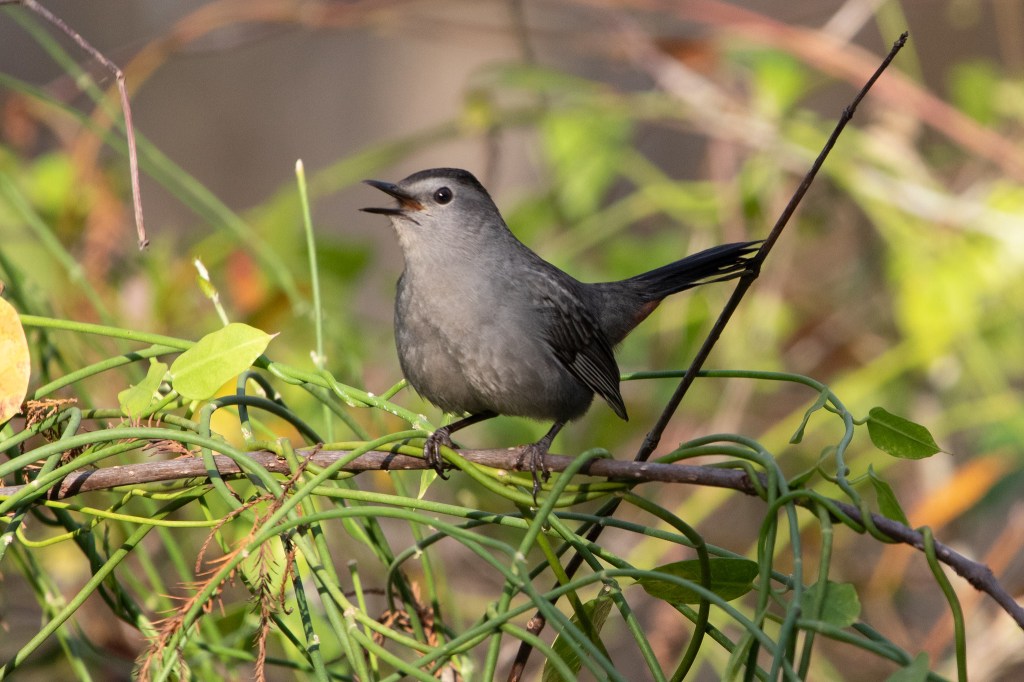Consider the gray catbird: the tropical long-distance migrant that may well be nesting in your backyard this summer.
Gray catbirds are common, so you may not pay them much attention. But look into the research, and you’ll find that this backyard bird is full of surprises. Let’s take a closer look.
As I write this, a gray catbird is singing in my backyard.
It arrived here in New Jersey several weeks ago and may already be building a nest with its mate somewhere in the neighborhood.
I am wondering where my catbird spent its winter – and whether this is the very same catbird that was in my yard last summer. Research on catbirds can help answer these questions.
Every spring, dozens of species of migrant songbirds make their way north from the tropics to settle into nesting habitats across North America. Indeed, half of all North American birds spend their winters south of the U.S. border – from Mexico through South America.
Most of these species are habitat specialists and we might see them in our backyards only briefly during migration as they make their way to more remote places.

The gray catbird, on the other hand, is a migrant from the tropics that is quite happy to claim a breeding territory in a wide variety of shrubby habitats, including suburban backyards.
The catbird singing in your backyard this spring is likely the same one that was there last year. Individual catbirds (and numerous other species) return to the same habitat patch to nest year after year, as long as they are fortunate enough to survive from one season to the next. Studies have shown a roughly 60 percent annual survival rate for catbirds.
If your backyard catbird has a lucky streak, you could see the same bird coming back for many seasons. The longevity record for a catbird is 17 years, 11 months.
This nearly 18-year-old bird was caught and banded as a young of the year in Maryland and miraculously encountered again by banders those many years later in New Jersey.
Banding can confirm the age of birds and also confirm that the bird in your backyard this year is the same one that was there last year.
Participants in programs like Neighborhood Nestwatch can observe their backyard catbirds wearing unique combinations of colored leg bands. These identify each bird as an individual and can be viewed with binoculars. For this project, researchers and participants alike can make observations on the identity and longevity of their catbirds.
Catbirds nest in 46 of the lower 48 United States and across southern Canada. They spend the winter across an equally broad area. A proportion stay in the U.S., where they primarily occupy the Gulf Coast and Florida. Some hearty individuals hang in there as far north as New Jersey.

Others go further south to the tropics – to the forests of Mexico, the Caribbean and Central America. There, they share the woods with jaguar, tapir, fer-de-lance and toucans.
Catbirds return to the same site on the wintering grounds every year as well. Your backyard catbird might spend the winter in the shadow of Mayan ruins in Guatemala or perhaps in the Florida Everglades.

We can make an educated guess on where your backyard catbirds spend the winter thanks to a recent analysis of banding records along with the use of tracking devices.
What this work tells us is that if a catbird breeds in the upper Midwest, it is more likely to be spending the winter in Central America. If it nests in the mid-Atlantic and New England, your catbird is likely spending the winter in Florida or the Caribbean.
As more studies like this one are carried out, we will have a further refined picture of “migratory connectivity” between nesting and winter sites. And we will be able to make even better guesses about where our backyard catbird might be next winter.
“A Few Raisins Give Him the Greatest Delight”
If you want to kick things up a notch for your backyard catbirds this summer, in addition to providing water, you can also offer them fruit.
As the poet Mary Oliver observes in her poem “Catbird”: “But a few raisins give him the greatest delight.”
One of the pleasures of a birding holiday in the tropics is watching birds at fruit feeders. After hours of seeking difficult-to-see skulking birds of the undergrowth and fast-flitting birds of the high tree tops, birding respite can be found at lodges and cafes that maintain fruit feeders for birds. Dozens of species of brightly colored birds come into easy view to eat banana, papaya and citrus at close range.
Catbirds bring a bit of this culture back with them from the tropics and are among the few birds at our northern latitudes that will readily eat soaked raisins, sliced orange and even grape jelly.
Back to my well-fed catbird. Is he the same bird as last year? Without banding him, I can’t know for sure. But I do know that he will do everything within his power to return here.

And return from where?
Maybe it is time to combine science with imagination. The science tells me that he wintered somewhere in Florida or the Caribbean.
But for better spatial resolution, my imagination is saying the Zapata Swamp of Cuba. Listen to what he sounds like there (in the audio file) … and then listen for the catbird in your yard!




Hi Joe, I have a catbird that has recently been visiting my deck several times a day to leave his droppings! I can clean it up and come back a few hours later and find it all over again! Is this a common trait? I’m talking …a dozen or more large spots!.
Catbirds in our suburban backyard here in Cary, North Carolina, sound almost IDENTICAL to a cat meowing. It is amazing. They come to our feeder, suet block, and bird bath every day. Enjoy watching them with their little, black feathered caps. Interesting birds to watch!
I’m followed around the yard by chipmunks, squirrels & bluejays as we live on the edge of a big forest. A catbird recently started appearing in the brush & tree branches above, following. Very quiet & shy at first- He now appears openly, to ‘ask’ for an unsalted, roasted, in-shell peanut. A very intelligent & crafty bird, indeed. Thanks for the great article about the wonderful catbird, btw!
I love my catbirds in eastern PA. I have a pair that are all about being protective over a large and tall Forsythia in the narrow side yard. I’ve seen one approaching the shrub with next material in mouth, but I can not for the life of me see where in the shrub it is. I’m wondering how long it takes for the gray cat bird to finish building it’s nest. Eventually, if it’s in that Forsythia one should be nesting in there.
There are 2 cat birds building a nest in a bush in my back yard. I have a six month old puppy that has bird dog in his blood. He is going absolutely crazy chasing them. Would it be a good idea to move the nest before it is complete. I can’t see how they will be able to lay eggs, have babies and feed them in peace with my pooch attacking them. I also worry that if it gets to that point, then will my dog become the target? Please advise asap. M
Hi Mark, If you decide to move the nest, do it before it is complete – that will give them a chance to start over sooner in a new location. Here is some good info on moving nests from The Spruce: https://www.thespruce.com/removing-bird-nests-386634 Thank you for the question!
When I was a kid, I spent a couple of weeks at a summer camp, like oh, so many kids do. It was in the wee hours of the morning when I heard what I knew to be a kitten in distress. I got up, got dressed and began peeping through the brush to find this poor kitty. It seemed, though, that every time I got close, the sound came from further away. I was so consumed by finding the kitten that I got lost. It turns out, of course, that I was chasing the call of a catbird all morning. Pretty embarrassing, but I would never forget what a catbird sounds like.
511/2018
Thanks for this beautiful and informational article…easy reads are just right at this time in my life as my son just died less then a month ago I’m grieving terribly for his loss. I always look at my birds out back he was so into nature! he was 31 planted many bushes to attract hummingbirds etc., but he didn’t live here but not far (he was in Phila.). So
I see so many cat birds since he died. I am always reading about birds and tried to Google but found nothing about their significance, we all know about the darling Cardinal in which I have many! Love them.
I will continue to look into Googling this and that was how I found your page.
I see hummingbirds in pictures by chance and it make me smile and I talk to him and thank him.
Birds have kept me sane through this loss watching them daily at my feeders…even the cat birds comes to the ledge on my deck (2 together) and I have never seen this? also reading up on them I hear them since so long and luckily found out that this bird music was from them since I saw one sing and then it meowed like a cat.
Joy they bring..all of the birds are precious…helps me get through a day.
TY for letting me vent.
Marianne D. Guzzardo
So sorry for your loss, Marianne. My wife lost her only child, her precious son at age nine back in 1994. We have parrots and enjoy nature and outside birds. We compensate for helping those who can’t help themselves by supporting animal shelters and rescues. Peace.
My backyard is full of catbirds.They have spent the winter at my house. I have found that they love old fashion uncooked oatmeal, cornflakes, plain donuts, bread and of all the fruits I have offered them dates are their favorite. Catbirds are fun to watch. They will take on Grackles if their fruit or oatmeal is
threatened.
Hello! Your cat birds may be my cat birds! I’m a Floridian, and have a pair in the thistles in my back yard. It’s late April, and I was wondering why these guys haven’t headed north, so I came to do research, and found your very interesting article. Hopefully they’ll be coming your way soon, and will have safe travels.
Do catbirds chase off other birds? Particularly bluebireds.
Hi Suzanne, Catbirds are territorial and will chase off other birds: https://www.allaboutbirds.org/guide/Gray_Catbird/lifehistory Thank you for the question!
Hi Joe, I have an injured Catbird. He/she flew into my window. He can’t stand on a branch but is eating & seems to be making progress. I’ve been giving him seeds, mealy worms & fruit. I was told if he can not be released back into the wild he would be euthanized. So, that’s why I still have him.
Can you advise me of anything else I should do? Thank you, Connie
Enjoyed the article. I’m a bird lover who has been observing this beauty in my yard. I have been putting up various feeders and variety of foods to attract different birds. The oriole feeder that I filled with orange slices and grape jelly didn’t bring the orioles that I hoped for (unless I didn’t catch them), but my catbird/s went for the jelly!
Central PA: Our catbird parents have done well this year. Their 3rd brood has left the nest this week. July 30th. So interesting to watch. The first two broods have stayed on to help with the new chicks. We offer them raisins and fresh water. They rule the yard like gang of thugs. There are only a few species they allow to visit. Dad has begun to chase off his own male offspring juveniles that have stayed on too long.
I had a pair on my property this year in southern Ontario. At mid June they just up and left. They’re nowhere to be seen or heard. I’m disappointed. Could they have been forced off by House Wrens? They arrived around the same time.
hi joe,
I live in the INTERLAKE of MANITOBA, CANADA. I am all excited today. We have three catbirds who have been
here for a few hours. they seem to be chasing each other around inside a dense shrub. One is carrying a
piece of dried grass. Could this be female with two male? I would love to here from you about this.
Thank you
Val
Hi Valerie, That is a possibility – they are territorial during nesting season and females do most of the work building the nest. The Cornell Lab of Ornithology has great information on the Life History of catbirds: https://www.allaboutbirds.org/guide/Gray_Catbird/id